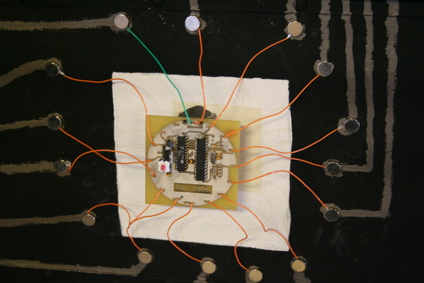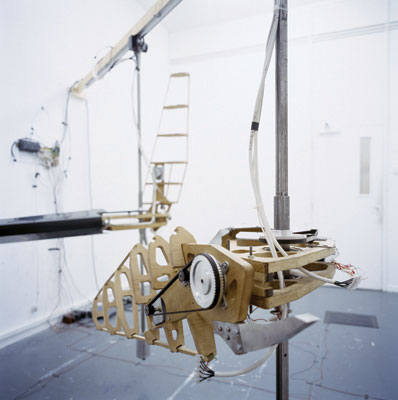Lower Prices on Ebay Auctions
For sale - all now at lower prices!
- Apple Powerbook G4 Aluminum 15" LVDS Display Data Cable (NB: I have 2 of these for sale).
Contact me if you want any of these and we can work out a deal.
SteamSHIFT out.

An archive of our old posts.
For sale - all now at lower prices!
Contact me if you want any of these and we can work out a deal.
SteamSHIFT out.

Graffiti Research Lab brought their portable lab (AKA matte black school bus). They used conductive paint to create traces to power LEDs mounted in strategic locations. Pictured is one of their programmable controllers for cycling the LEDs.
I have known that you could buy conductive paint for a long time, but I think this is the first time I've see it and begun to see some possibilities for it. Perhaps in an interactive installation where the viewers are invited to create their own circuits?
Thanks to: Maker Faire (Part 2) - Engadget
In trying to set up FTP access on another Mac with OS X server, I realised that I missed a point in my previous short tutorial:
Before doing anything else, go into Workgroup Manager, and click on the ‘Sharing’ button at the top. There should be 2 tabs underneath - ‘Share Points’ and ‘All’. If the parent of the directory you want to allow access to is in the list, all good - you don‘t need to do anything else. If not, then click ’All‘, find the parent of the directory you want to share and click on it. Then in the right hand pane, under ’General‘, enable ’Share this item and its contents'.
Then carry on with the tutorial as before.
Hope this helps someone. SteamSHIFT out.
I've been mucking around with connecting up a Basic Stamp 2 to MIDI, for building controllers, however I have to admit, that when it comes to analogue to digital conversion, I‘m a little out of my depth with the electronics; I’ll persevere because I want to beat the problem, but that doesn't stop me wanting alternatives.
Which is where Phidgets come in. They are straight forward controllers that connect directly into USB or via a interface module that handles a number of sensors. They are pretty cheap - £60; or so for the interface module and seem to be pretty easily programmed - although most of the code out there is PC based. (available in the UK here)
Interestingly there is a Flash API which could open up some interesting possibilities.
I have been looking at them with regard to Quartz Composer, but I think the main sticking point is going to be communication between qc and the interfaces. I suspect that some sort of plug-in for Quartz Composer incorporating the phidget C API, is the only real way forward.
10 years ago, during my degree we were always looking for ways to connect Director to physical interfaces - we usually ended up hacking mice and keyboards. Communication between Director and the Basic Stamp via serial always seemed a bit flakey. 10 years on and I feel like I am back there with Quartz Composer; there are loads of good ways of getting info into it, but very few ways of getting feedback out (back then, I ended up taping light sensors to the bottom of the screen and changing the colour of blocks of pixels).
SteamSHIFT out.
Thanks to Phidgets come to Mac OS! - MacResearch
I know a few people who use Firefox in preference to Safari, but despite the number of plug-ins available for it, it's just not Mac-like enough for me. Camino uses the same engine, but is built using Cocoa. It looks Mac-like and runs really fast.
I don‘t really want to change, but Safari keeps hogging memory - often as much as 200Mb of physical memory - that’s more than Photoshop! I probably restart it 4 times a day just to free up some RAM. So i‘m flirting with Camino to see it it is any better. I’ll let you know.
SteamSHIFT out.
Once more, Google does the business! I typed in ‘precision series e-400 sweep generator’ and within minutes I found several really useful links.
There‘s a few photo’s up on my Flickr account, but here's one for starters.
Originally uploaded by steamshift.
So on to the good stuff…
Technorati Tags:
hardware, technology, vintage, electronics
First up general information from www.radiomuseum.org:
Sweep Signal Generator E-400 (E400) Radio Precision Apparatus
Country:
United States of America (USA)
Year:
1948
Manufacturer/Brand:
Precision Apparatus Co. Inc.; NY
Type:
Radio Repair Equipment
Model ID:
75856
Wave bands
Wave Bands in notes or not known yet.
Power type and voltage
Alternating Current supply (AC) / 110 Volt
Material
Metal case
Valves / Tubes
8: 6J6, 6C4, 6C4, 6J6, 6C4, 6J6, 6X5, 0C3
Notes:
Generator frequency 2-240 MHz, sweep frequency deviation 0-1 MHz and 0-15 MHz.
Great stuff. I now have confirmation that it was made in the US and runs on 110v - very useful (though I will need to figure out how much current it draws so I can get a sufficiently rated transformer). Also very useful to have the list of valves; on the site, there are links to data about each one, with alternatives.
Secondly, thanks to Paco - a page with links to loads of manuals to old electronics, I found this:
E-400: Manual for Precision E-400 Sweep Signal Generator. Compliments of an unknown contributor.
Awesome. It came down in djvu format which I've never heard of, but I was able to get an application to open it from here. A quick PDF export later (I love OS X!) and I have a really useful PDF manual of how to use the Sweep Signal Generator.
So, from the manual we have the following description:
The PRECISION Series E-400 Sweep Signal Generator is a wide range multi-purpose frequency modulated Signal Source specifically designed for alignment and service of television, F.M. and other high frequency type receivers and circuits.
Great. So now I've got in depth info, what can I do with the thing? For now, SteamSHIFT out.
(Thanks to Paco and Radiomuseum.org.)
Originally uploaded by steamshift.
The insides of the sweep generator that I bought recently - look at that beautiful vintage electronic goodness!
I have no clue (having not yet read the article) what these 2 machines do, but they look great!
PODNET (post-digital architecture network) event

Emanuel Vercruysse, Interactive Architecture, Bartlett

Sam Hobson, Clinimanic Studies, Bartlett
I often bemoan the lack of a decent art school in Southampton, and that the bulk of the students seem to be involved in Medicine or Engineering. However, now and then, something comes up (thanks Matt), that makes me think that that might not be such a bad thing. Check out the Research and Activities sections for some of the exciting work they are doing in the field of Sustainable Energy.
SteamSHIFT out.
Technorati Tags:
Southampton, ecological, sustainability, green
I started blogging in earnest around July / August last year, having decided to use this blog as a tool for collecting and exploring ideas with reference to doing an MA in Art, Design and Media at Portsmouth, UK. That fell through at the time, but I have really enjoyed the blogging bit.
Of course, nothing is wasted, I still have a good library of projects and ideas that I have been working on over the 9 months and have had some good comments and feedback.
I still want to do the MA, but I have been exploring the idea of doing it at Plymouth; partly because they have an online focus to the course (most of the course is done online), but also because they seem to be doing some really interesting work down there.
Oddly enough, the guy who heads up i-DAT (Institute of Digital Art and Technology) is Roy Ascott who set up the Interactive Arts course at Newport that I graduated from nearly 10 years ago. Funny how these things work out sometimes.
We'll see. SteamSHIFT out.